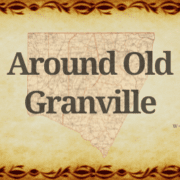Many folks who were born and raised in Henderson or Vance County either remember the 1958 cotton mill strike or have grown up hearing stories about it. But even the youngest mill workers during that time are in their 80’s now, so there are fewer and fewer folks still alive to tell the story of how the strike affected the community then and now, more than 60 years later.
In Thursday’s Around Old Granville segment of TownTalk, WIZS’s Bill Harris and local historian Mark Pace add some context to the events that led up to the strike, which lasted until 1961.
In 1895, brothers David Y. and John D. Cooper founded the Henderson Cotton Mill in North Henderson.
They’d made their money in the tobacco business after the Civil War ended and later set their sights on establishing a mill.
Textiles, tobacco and furniture, Pace said, were all North Carolina industries that began with a “relatively cheap raw material that you could manipulate into something much more profitable.”
The profit margins were much higher in textiles than for, say, tobacco, but it came with more risk, Pace explained.
The price and quality of the raw material, workers’ wages and overseas competition were just some of the factors that the Cooper family had to consider with the mills, which numbered three by 1913. Harriet Mills opened in South Henderson in 1909 and then Harriet Plant No. 2 opened in 1913.
“It took off like gangbusters,” Pace said. Indeed, the textile industry was not only big in Henderson, but also in the southern United States, possibly “the most important industrial endeavor in the South, even up until the 1980’s and 1990’s,” Pace said.
It was 1943 when the union first came to the Harriet and Henderson plants, he said. By this time the mills were under the leadership of John D. Cooper, Jr., who ran it until 1962, Pace said. By the time World War II ended, the U.S. found itself in the unique position of being pretty much the only textile producers left – between the devastation across Europe and civil wars in India and Pakistan, the domestic textile industry was looking good.
Harris said a post-war economic boom led to a 1949 downturn, and as other countries rebuilt and retooled, it was more difficult for the local mills to keep their equipment current.
“They were very forward thinking,” Pace said, and wanted badly to modernize the mills after World War II, but faced years long backorders as a result of post-War reconstruction.
Throw in the rise of synthetic textiles like rayon and nylon – no cotton needed – and the textile industry began to falter.
Harriet and Henderson produced thread and yarn from the raw cotton, and employed as many as 1,000 people during its peak, when it was the largest yarn manufacturer.
“Within the confines of the industry,” Pace said, the Coopers were “very innovative and forward-thinking.”
To keep the mills running despite high absenteeism, management had dozens of employees at the ready each day to fill jobs when employees didn’t show up for work, Pace said. Even if they weren’t needed inside the mill, the stand-by workers would get two hours’ pay for showing up.
“A lot of plant managers would not have put up with that,” Pace said of the often high absentee rate. “But the Coopers wanted the work force to be happy.”
Women made up half the work force, and sometimes had to take off with little or no prior notice but management tolerated it because they felt an obligation to the workers, he added.
Pace said he considers the mill strike of 1958 as one of the top two or three most important events in the history of Vance County, “right up there with Civil Rights or the coming of the railroad and the creation of the tobacco industry.”
Listen back to the entire show at www.wizs.com.
CLICK PLAY!

